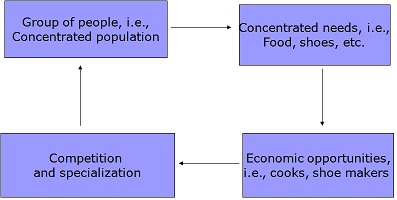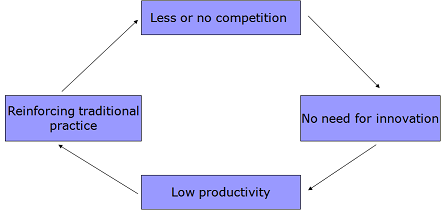Human settlement
Throughout history humans have almost always settled on the best available places in terms of natural resources (food, water) and locality (transport, etc).
- This fertile land allows intensive agricultural activity to support a large population
- The locality means trading can bring even more resources to the area.
- This allows a bigger sustainable population and the exportation of local produce (which in turn facilitates the establishment of a trading zone → bigger population, etc…)
With more natural resources & manpower it becomes possible to upgrade infrastructure (roads, irrigation, etc) and set up a government. In other words a centre emerges - this could be a city state, kingdom or even an empire.
However, not all human settlements expand into large commercial centres. Reasons for this could be:
- Limits imposed by environmental constraints (food, water, space)
- Political constraints (government controlling the size of urban development)
- Military uncertainty (need to build compact defendable cities)
If we remove all of these constraints we are left with a positive feedback system resulting in the emergence of commercial and political centres.

- Once the population reaches a critical mass, competition arises because of the increase in supplies and services.
- Competition leads to specialisation
- Specialisation leads to higher productivity → capacity to support a larger population → concentrated population (cities)
City dynamics
Because of specialisation within a city there is a need to produce the best quality products possible. In order to create a better product, it is more effective to specialise in producing one thing. This may require training from a third-party, such as a trainer or educational institution.
In many aspects, city dynamics are similar to those of a tropical ecology:
- Constant high energy throughput
- Large number of species
- Highly specialised species
- Species have a narrow niche width
From the perspective of a city:
- City needs a huge amount of energy / material provided by primary, secondary and tertiary industries
- Different sectors demand different skills (specialised professionals)
- High diversity of products
- Demand for training or education
- Anonymity
- Exploitation of innovation and changes (with less social constraints people are free to exploit these for economic gain)
- Smaller family
- More mobility (people not able to establish a sense of belonging; people on the move become foot loose = less involvement in local activities, less ability to make long-term plans, feelings of insecurity)
- Less stability (in terms of social structure)
- Anonymity, smaller families, mobility → less stability, impact on health, other impacts not yet discovered…
Hinterland dynamics
Migration to the city centres leaves a sparsely populated area around the city called the Hinterland. The main economic activities in these areas is agriculture, and in terms of energy and material flow they are similar to the polar ecology:
- Highly volatile low energy throughput
- Low number of species / biodiversity
- Species tend to be generalists
- Species have a wide niche width (able to survive under a wide range of conditions)
From the perspective of the Hinterland:
- Low energy and material throughput
- Less or no specialisation (little competition)
- High ecological constraints (people more exposed to natural elements; drought, flood etc are a bigger threat to life)
- Same skills handed down from generation to generation (little or no innovation)
- Strong constraints from cultural and practical traditions (also more cultural homogeneity and social cohesion → less tolerance, more social support)
- Damp changes (various constraints will dampen/prevent changes)

Centre-Hinterland interaction dynamics
- City's mass production out-competes local craftsmen, leaving them unemployed
- City capitalist may control the supply of raw materials
- Hinterland looses control of its resources to the city
- These issues can lead to villagers immigrating to the city in pursuit of employment.
- Polarisation of wealthy minority in the city surrounded by poverty stricken hinterland
In the contemporary world, the centre-hinterland demographic transition is happening in a global scale with the developing countries providing cheap human and natural resources for the developed world. These includes the ecological resources such as clean water, land, and labourer.
Information, knowledge and the technological change machine
- Information: can be any collection of data (/signals/patterns)
- Knowledge: based on information organised into some structure.
Throughout history, information and knowledge have been stored and shared via different methods:
- Memorisation
- Books (block-wood printing invented circa 700AD, arriving in Europe 1300AD)
- The mass-media (information explosion during 2nd half of 20th century)
Information and its availability have affected the complexity of technology throughout the ages…
- Wooden cart vs motor car
Two factors determine whether trial-and-error will be the main source of a product's development; the complexity of the design and the amount of information that is available concerning the problem/design.

Dynamics of the Science-technology machine
If we represent science & technology as a 'machine', it has the following traits:
- Transforms the social and ecological environment
- Transforms itself (theories, experiments, scientific organisation)
- Transforms the resource(s) supporting the machine
- Transforms the process of evolution of the society (changes the evolutionary path of humans and society as a whole)









